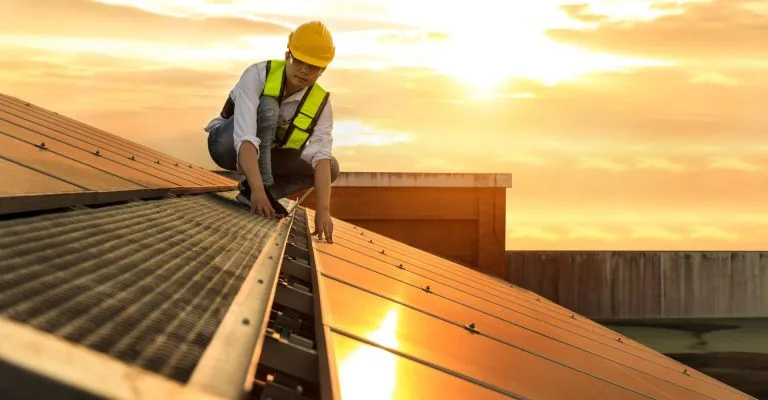The residential solar industry is evolving faster than ever. For homeowners considering a transition to clean energy, understanding the latest Solar Panel Installation Trends in 2025 is key to making informed investment decisions. From integrated battery systems to aesthetic solar shingles and smarter financing models, the solar landscape is becoming more efficient, accessible, and visually appealing.
This guide will walk you through the most impactful trends shaping residential solar adoption this year — and how they can help you achieve greater energy independence, maximize savings, and future-proof your home energy system.

Understanding the Key Solar Panel Installation Trends in 2025
1. The Rise of Integrated Battery Storage
The biggest shift in 2025 is the rise of solar-plus-storage systems. Affordable lithium-ion and LFP batteries now allow homeowners to store excess daytime energy for nighttime use or grid outages.
Why It Matters:
Battery systems like the Tesla Powerwall, Enphase IQ Battery, or LG RESU provide energy independence and protect you from utility rate spikes or blackouts. With many states revising net metering rules, storing your energy for self-use is now more profitable than exporting it to the grid.
🔗 Learn more about solar storage technology at Energy.gov.
2. Enhanced Efficiency and Monocrystalline Dominance
Modern panels now exceed 22% efficiency thanks to N-Type and PERC cell technology. These next-generation panels perform better under low-light and high-temperature conditions, which boosts annual energy yield even on compact roofs.
What It Means for Homeowners:
Higher efficiency equals higher output from fewer panels — perfect for homes with limited roof space. Plus, manufacturers now offer 25-year product and performance warranties, ensuring longevity and stable ROI.
5 Key Installation Strategies for Modern Homeowners
3. Prioritizing Aesthetics: The “Invisible Solar System”
Today’s solar panel installation trends emphasize design harmony.
-
Solar Roof Tiles (BIPV): Products like Tesla Solar Roof integrate panels directly into shingles, blending with the home’s architecture.
-
All-Black Panels: Slim black frames, concealed busbars, and low-profile mounts deliver a premium look that enhances curb appeal.
4. The Shift to Microinverters and Power Optimization
Traditional string inverters are giving way to microinverters and power optimizers.
Benefits:
Each panel operates independently — shading or malfunction in one panel doesn’t drag down the rest.
Microinverters (e.g., Enphase) convert DC to AC right at the panel, while optimizers (e.g., SolarEdge) improve efficiency with central inverter setups.
5. Smart Home Integration and Real-Time Monitoring
Homeowners can now monitor and control solar production via smart apps, adjusting energy usage for maximum efficiency.
-
Real-time dashboards show power generation, consumption, and storage status.
-
Integrated systems can automatically route solar energy to EV chargers or HVAC systems during peak sunlight hours.
💡 Tip: Choose a system that supports integration with your smart home ecosystem (Google Home, Alexa, or Home Assistant).
6. Understanding Modern Financing and Incentives
The financial side of solar panel installation in 2025 is more flexible than ever.
| Financing Option | Description | Pros | Cons |
|---|---|---|---|
| Direct Purchase (Loan/Cash) | Own your system outright. Eligible for 30% Federal Tax Credit (ITC). | Best long-term ROI | Higher upfront cost |
| Lease / PPA | Pay a fixed rate for solar energy; installer owns the system. | No upfront cost | Fewer long-term savings |
| Green Home Loan | Special low-interest programs for energy-efficient upgrades. | Combines solar + HVAC or insulation upgrades | Qualification required |
📘 See the official U.S. Department of Energy Guide for current incentives and rebates.
7. The Importance of Professional Installation & Certification
Solar panel installation requires technical precision. Always choose certified professionals.
-
NABCEP Certification: The gold standard for solar installers in North America.
-
Workmanship Warranties: Ensure your installer provides at least a 10–25 year warranty for labor and installation quality.
🔗 Verify your installer at the NABCEP Installer Directory.
Navigating the Installation Process & Future Outlook
When requesting quotes, homeowners should prioritize transparency, not just price.
Procurement Checklist:
-
Get 3+ competitive quotes with full component details.
-
Compare efficiency, inverter brand, and warranty terms — not just total cost.
-
Ensure the quote includes permits, inspections, and interconnection fees.
Looking Ahead: AI and Home Energy Management Systems (HEMS)
Beyond 2025, the next frontier is AI-driven energy automation.
Home Energy Management Systems use predictive algorithms to:
-
Forecast solar production based on weather data,
-
Balance consumption vs. storage,
-
Decide when to power EVs, batteries, or the grid.
These smart systems turn every home into a mini power plant — autonomous, efficient, and sustainable.
Frequently Asked Questions (FAQ)
Q: Will solar panel installation damage my roof?
A: No — professional NABCEP installers use engineered mounting systems with weatherproof sealing. If your roof is old, replacing it before installation ensures the system’s full 25–30-year lifespan.
Q: How long do modern solar systems last?
A: Panels typically last 30–40 years with 25-year performance warranties, guaranteeing 80–85% output at year 25.
Q: Which is better — solar loan or lease?
A: Loans/Direct Purchase offer ownership, ITC eligibility, and higher ROI. Leases and PPAs require no upfront payment but provide smaller long-term savings.
Internal Resources
If you’re considering home energy upgrades, you might also like:
